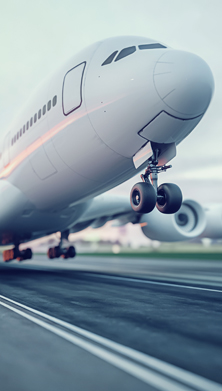1. Safety milestone reached but losses continue
With more reliable engines and technology and following significant improvements in airline risk management, there are now far fewer serious accidents. According to the International Air Transport Association (IATA)1 there was just one major jet accident for every 8.7 million flights in 2017 – some 4.1 billion travelers flew safely on 41.8 million flights.
“For the first time in more than 100 years of aviation history, there were no fatalities on a commercial airline, a remarkable achievement by any measure,” says Kevin Smith, Aviation Claims Specialist at AGCS. “This is not an aberration. Flying has become a much safer mode of transport and is the result of the considerable efforts of aircraft and engine manufacturers to get to this stage.”
With more than one million people in the air at any one time, this impressive statistic is to be applauded. However, 2018 saw a number of fatal airline accidents, the worst being the loss of a Lion Air Boeing 737 off Indonesia in October 2018 which went down shortly after take-off with the loss of 189 people. This incident followed the loss of a Cubana de Aviación Boeing 737 in May, which also crashed shortly after take-off, killing all but one of the 113 passengers and crew. In addition, 2018 also brought a number of total hull losses, where all passengers survived. For example, a Pegasus Airlines Boeing 737 was written-off after it overshot the runway at Trabzon Airport, Turkey, in January, while a Xiamen Airlines Boeing 737 was declared a total loss after it crash-landed in bad weather in August. Similarly, 103 people survived a crash involving an Aeroméxico Embraer ERJ-190AR in July, although the aircraft was destroyed.
2. Human error a major loss factor
Technological advancements and improved quality control of aviation manufacturing and maintenance has significantly reduced the number of accidents caused by mechanical or structural failure. Consequently, human error has become a more significant cause of loss.
“Pilot error is a major factor behind many aviation accidents,” says Smith. “It has been estimated that as many as 95% of airline accidents involve human error in some capacity. Aircraft are now very safe, but most accidents involve errors of judgement, such as taking off in bad weather or the way in which a pilot reacts in adverse conditions.”

3. Increasing claims frequency and aircraft values
While catastrophic air crashes are thankfully now far less frequent, the overall frequency of aviation claims is slightly up, due to a combination of higher repair costs, increased values and the relatively low deductibles
maintained by airlines in what has become a highly competitive insurance market. The average deductible at $1mn today is around the same as it was in 1982, yet aircraft values have increased three fold, explains Smith.
“Despite few major losses and no fatalities in 2017, the aviation insurance market barely broke even – a reflection of market conditions and attritional losses. Claims frequency is up, but this is not the only factor. The size of loss has increased and deductibles have not kept pace with technology and values. A $5mn loss today would probably have cost just $1mn five years ago and been within the deductible.”
4. Rise of composite materials and more expensive engine repairs
The use of composite materials in aircraft manufacturing really took off around a decade ago, and today the majority of the world’s commercial airline fleet now relies on such materials. Composites – such as carbon fiber layers bonded with resin – are strong, but also light, therefore reducing weight and increasing fuel efficiency. Such materials are now used extensively in modern aircraft – some 50% of Boeing’s 787 Dreamliner2 is made of composite materials by weight.
“Composite materials have many benefits, but they can be more challenging and expensive to repair. Aircraft manufacturers may not have
envisaged the realities of repairs when developing these materials a decade or so ago,” says Smith.
The claims experience has revealed a higher repair cost associated with composite materials, which are generally more expensive to manufacture than traditional metal alloys, more labor intensive to repair and often
require a larger repair area.
“We are now at the stage where we have had some seven or so years of claims experience with composite materials and we can say that composite aircraft are more expensive to repair,” says Smith. For example, a claim involving a fire under the front landing gear of a Boeing 787 cost $13mn to repair. The same incident for an older generation metal alloy
aircraft would have cost somewhere between $3mn and $4mn.
While safer and more reliable, aircraft engines are also now much more expensive to repair or replace. Top-of-the-range engines used on the Airbus A350 can easily cost more than $40mn each – just under the value of a whole Boeing 737 a decade ago.
The drive for fuel efficiency has resulted in lighter engines that fly longer distances. However, technical advances, such as the use of new materials and thinner, lighter turbine blades, have reduced the tolerances at which
engines components operate, while the cost of spare parts has also increased.
5. Congested airports bring more attritional claims
In addition to increased repair costs, insurers are seeing more attritional claims. The rapid growth in air travel – the number of air passengers is expected to double to 7.8 billion by 20363 – has resulted in more congested skies and airports.
“With increased air travel, congestion in and around airports has become an issue,” says Smith. “In many cases airport infrastructure has not kept pace with the rapid growth in passenger and aircraft numbers. With more aircraft on the ground, servicing areas and aprons have become more congested and this is resulting in an increase in the number of collisions with other aircraft or ground handlers.”
Analysis of 523 loss events at 14 German airports last year by AGCS shows that damage to vehicles on the tarmac is the leading cause of insured losses. More than half of these events are due to collisions with pushback
tractors, baggage trolleys, aerial work platforms or washing systems.
For example, the introduction of a new form of tow-truck (that wraps around an aircraft’s front landing gear) resulted in several large claims. A number of tow-trucks have caught fire while in operation, damaging aircraft – one resulted in the total loss of a Boeing 777.
6. New risk drivers: automation, pilot shortage, cyber and drones
Aircraft and airlines are increasingly reliant on technology – from aircraft to ticketing. An A350 aircraft today sends some 400,000 computer messages to ground controllers during a six hour flight, 60% more than the older A380. The technology for crew-less commercial passenger aircraft already exists, but the reality is many decades away. However, aircraft are likely to become increasingly automated, driven by the desire to reduce costs and because of a predicted shortage of pilots – Boeing has said over 600,000 pilots will need to enter the industry over the next 20 years. According to Smith, flights with just one crew member on the flight deck, with ground
support, would have implications for crew skills and training, as well as how they deal with adverse conditions.
Then, there is threat to the sector posed by technology or cyber-related losses, such as physical damage to aircraft and resulting business interruption and IT system outage. To date there have not been any major aviation claims triggered by a cyber incident, although insurers have paid out on some indirect cyber claims. For example, AGCS settled a liability claim from passengers seeking compensation for flight cancellations caused by a ticketing system failure.
While crewless passenger aircraft are some way off, autonomous flight is an emerging area for aviation insurance claims. AGCS has a growing global book of drone insurance, and has seen a corresponding increase in claims. As drone usage broadens into different areas, claims will become more relevant, says Smith.
“Drones will increasingly become part of an aviation insurer’s portfolio as they become more prevalent, larger and more sophisticated. This is an emerging market, so we cannot yet draw conclusions from the small number of claims. We have seen some, but so far these are mostly hull losses rather than liability claims,” Smith concludes.
SOURCES
1. IATA Releases 2017 Airline Safety Performance, 22 February 2018, International Air Transport Association
2. 787 Dreamliner By Design, Advanced Composite Use, Boeing website
3. 2036 Forecast Reveals Air Passengers Will Nearly Double To 7.8 Billion, 24 October 2017, International Air Transport Association















